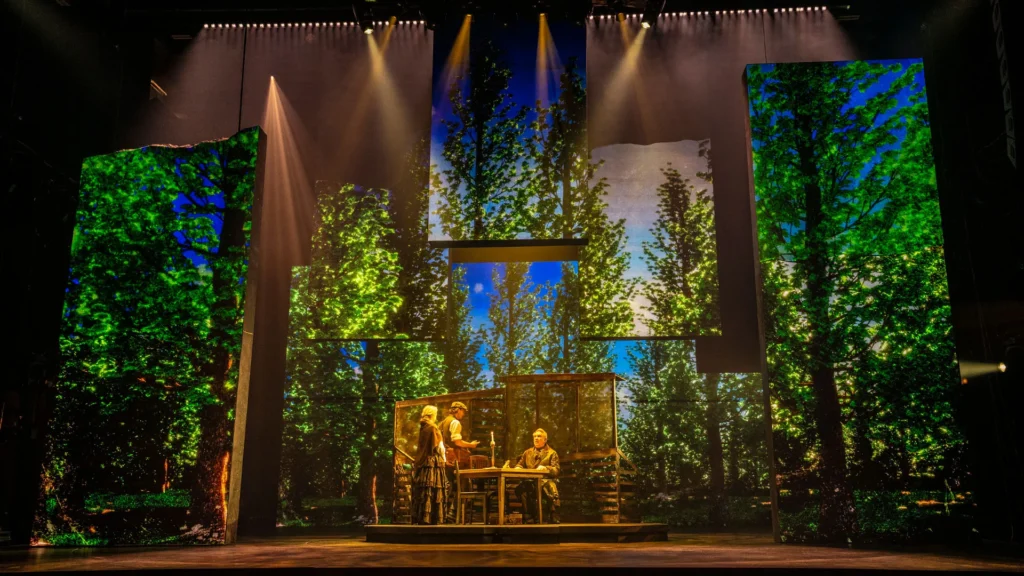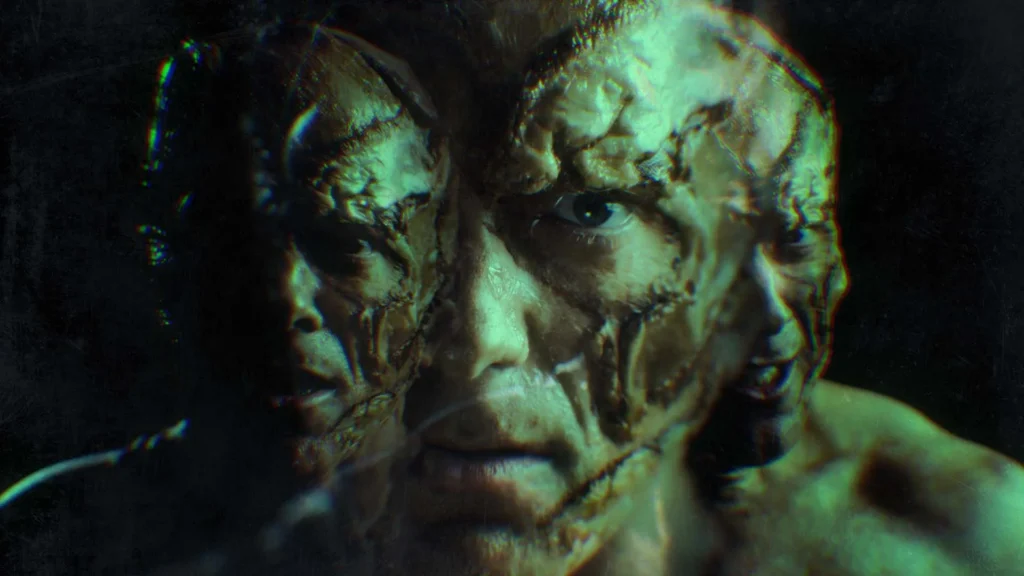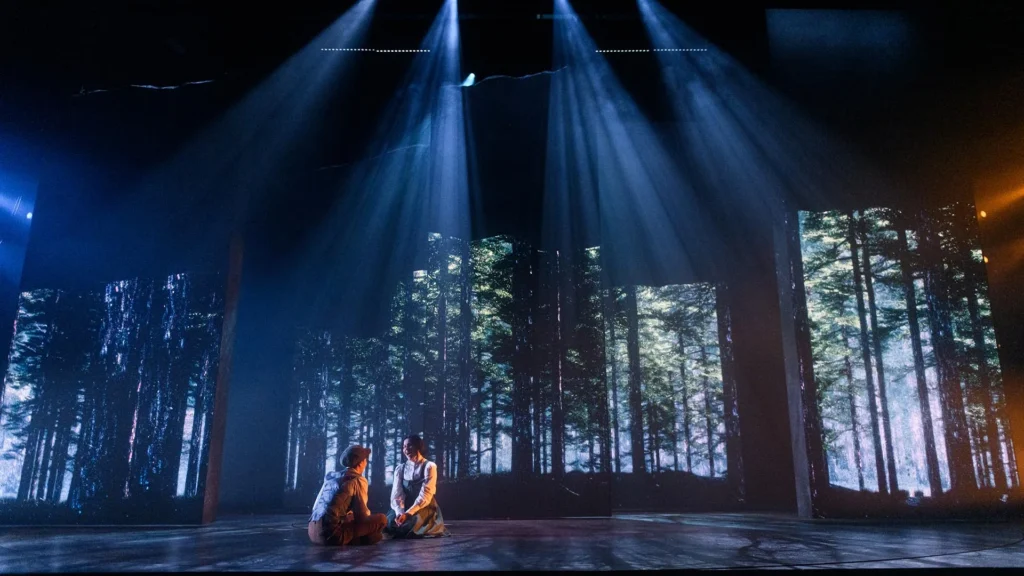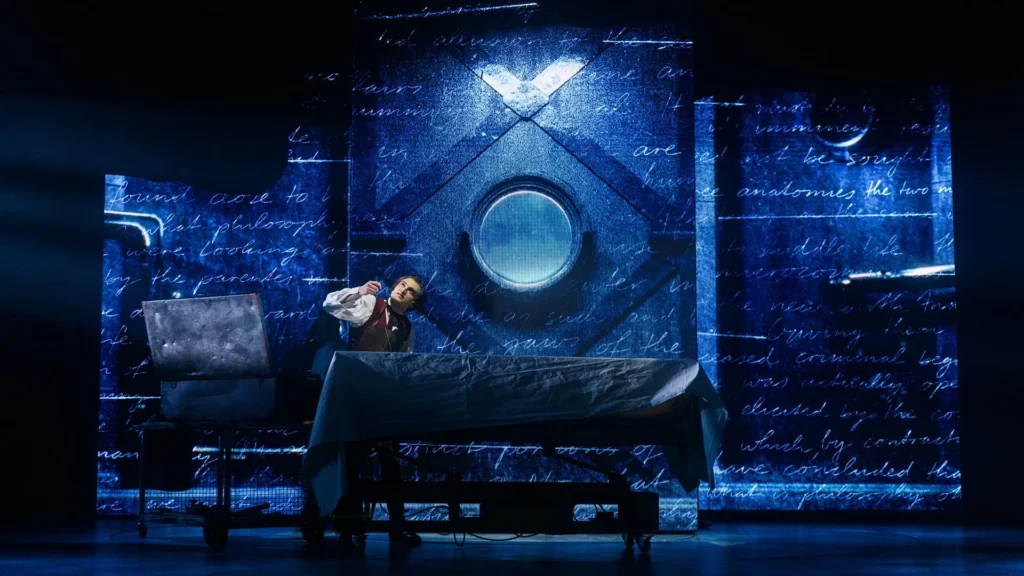This stage adaptation of Mary Shelley’s Frankenstein honours the sociopolitical complexity of the original text while deploying contemporary scenographic techniques to enhance its thematic and psychological depth. At the heart of the visual dramaturgy is a layered video design that amplifies the narrative’s horror and subjectivity, extending the scenic world and enriching transitions in time, space, and emotional state.
The production adopts a filmic narrative structure, with frequent temporal and locational shifts. This demanded a flexible and responsive visual system capable of supporting rapid transitions while maintaining coherence across aesthetic and spatial logic. Video design was developed in close integration with scenic elements, realised primarily through a dual system: a rear projection surface and LED walls embedded within sculptural tomb slabs.
 Video Design Concept Renders
Video Design Concept Renders
These LED-integrated tomb structures functioned as both scenic architecture and narrative device—anchoring the physical environment while also serving as a mutable surface for digital content. This allowed for seamless spatial transformation without interrupting performance sightlines or creating projection shadow issues, enabling dynamic interplay between performer and image.
 Production Photography — Joel Devereux
Production Photography — Joel Devereux
As a memory play structured through epistolary narration, the production is largely seen through the fractured perspective of Victor Frankenstein, with occasional shifts into the Creature’s gaze. The visual language was designed to reflect this subjectivity: transitioning from illustrative landscapes to more surreal and psychological imagery. This was particularly evident in sequences visualising Victor’s inner torment—where ink bleeds, paper textures, and layered imagery evoked the act of writing, remembering, and disintegration.
The tomb slabs served as the central scenographic motif—simultaneously evoking weight, permanence, and death, while being fractured and reconstituted through video. The fusion of LED and stone metaphorically referenced the Creature’s own construction: a body of disparate elements bound together. The LED structures provided a consistently lit, controllable canvas for content delivery and allowed for calibrated responses to key narrative beats, such as the burning of the Delaceys’ home and the moment of reanimation.
The rear projection surface expanded the visual field beyond the physical architecture, supporting shifts from intimate to epic scale. This surface was used to extend landscape vistas, suggest memory states, and enhance transitions without introducing additional physical scenic changes. The balance of LED and projection allowed for multi-scalar storytelling—tight, psychological focus on the tomb slabs contrasted with broader contextual environments rendered behind the action.
 Video Design character pre-record used as part of a psychological nightmare sequence.
Video Design character pre-record used as part of a psychological nightmare sequence.
Content development utilised a hybrid toolkit:
- 3D-modelled scenic environments augmented with volumetric lighting and simulated atmospherics, created in Cinema 4D.
- Manipulated archival footage processed to evoke period and location authenticity while remaining stylised.
- Pre-filmed portraiture of the cast to visually represent memories, nightmares, and internalised guilt.
- Animated transitions based on ink and paper textures to reinforce the literary origins of the narrative and provide thematic continuity between scenes.
The palette was tightly controlled—muted, desaturated tones dominated Victor’s memory sequences, while saturated, vibrant hues accompanied the Creature’s discovery of the world. These chromatic shifts articulated narrative perspective and emotional resonance. Custom transitions using procedural effects (ink bleeds, disintegration, ghosting) were employed to provide stylistic cohesion and underscore the internal psychology of the characters.
 Production Photography — Joel Devereux
Production Photography — Joel Devereux
Collaboration between video and lighting was essential in achieving a unified scenographic logic. Lighting cues were tightly synchronised with video content to ensure continuity of texture, directionality, and atmosphere. For example, gobos mimicking cobblestone textures in lighting were reflected and extended within video content; kinetic lighting effects (e.g., fan blades) were composited into the video design to blur the boundary between physical and digital scenography.
A significant production challenge of the original season was the remote programming and execution of the video design during the final week of rehearsals and technical runs. The system was supported by a real-time HD camera feed from the theatre, integrated communications with the local team, and remote access to the media server. Cloud-based asset management enabled rapid iteration, file transfer, and live updating of content throughout technical rehearsals and previews. This remote workflow proved robust, allowing for collaborative decision-making and responsive refinement in alignment with evolving directorial and technical needs.
 Production Photography — Joel Devereux
Production Photography — Joel Devereux
This adaptation of Frankenstein posed complex technical and dramaturgical challenges: integrating memory, morality, and monstrosity into a visual system that is both deeply psychological and theatrically present. The result is a hybrid scenographic space where video, performance, and material design converge—sustaining narrative clarity while embracing the fractured, unreliable nature of memory and creation.
Read more about the production here.
